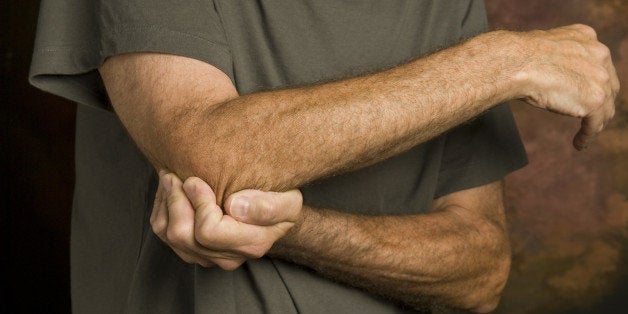
Tennis elbow, or "lateral epicondylitis," is a misnomer. In fact, fewer than 5 percent of patients with this condition actually play tennis! It usually results from daily repetitive overuse from gym exercise or too many hours at the keyboard. Patients complain of sharp pain at the outside aspect of the elbow over the bone, worse with shaking hands or grabbing a milk carton. While the medical lingo refers to the condition as an inflammatory process, it is quite the contrary. Tendons are elastic ropes in our body that connect muscles to bone and absorb a lot of stress. Unfortunately, they have very poor blood flow, which results in failed healing with scarring and lots of pain.
New cellular research has changed the way we treat tennis elbow. Here are seven ways you can ace tennis elbow:
1) Address the underlying cause. If the pain is sport- or activity-specific, you must improve your technique or ergonomic setup. Have your workstation evaluated or consult with a personal trainer to make sure your technique is sound.
2) Home stretching exercises. Tennis elbow results when the forearm muscles get too tight and cause increased tension on the bony attachments of tendons. Simple stretches to loosen up your forearms can help when the problem is in its early phase.
3) Receive deep tissue work or massage to improve blood flow. You probably developed this pain from overworking, so treat yourself to a high quality massage! This may break up scar tissue to facilitate healing when the issue is new within the first six weeks. A physical therapist may also perform this technique.
4) Put a brace on it. A counter force brace can offload the overworked tendon by redistributing the pressure and can provide immediate relief.
5) Topical creams. Prescription-based anti-inflammatories have been shown to be effective since 1998. Alternatively, a pharmacist can create a custom cocktail including lidocaine an anesthetic or gabapentin for nerve like pain. Topicals may reduce the side effects typically seen with oral medications.
6) Avoid repeated cortisone injections. By now studies have confirmed that not only do steroid injections provide only short-term relief, they can directly damage tendons, increasing risk of rupture.
7) Inject your own blood platelets to boost healing. This popular blood spinning procedure has been shown to be much more effective vs. cortisone at two-year follow up and recently was shown to be 84 percent effective in the world's largest multi-center placebo controlled clinical trial for platelet-rich plasma (PRP). This therapy is best for chronic non-healing tendons, as results may take 4-6 months for healing to occur.
Most cases of tennis elbow will self resolve within two years, but these seven tips can help speed the process to get you back on the court -- or, more likely, back on the keyboard!
For more by Steven Sampson, D.O., click here.
For more on personal health, click here.